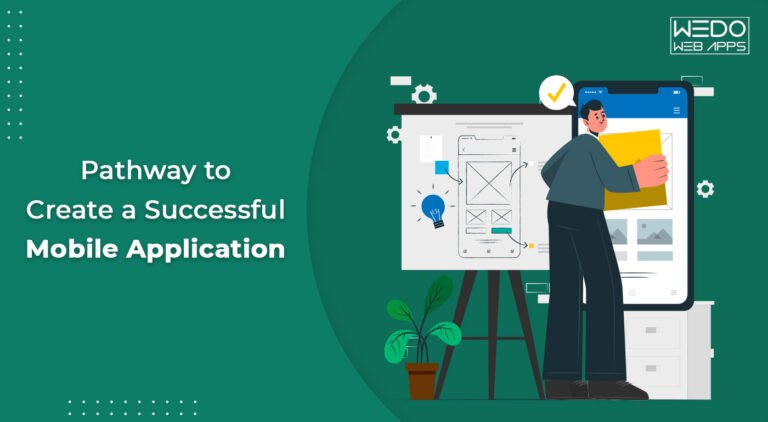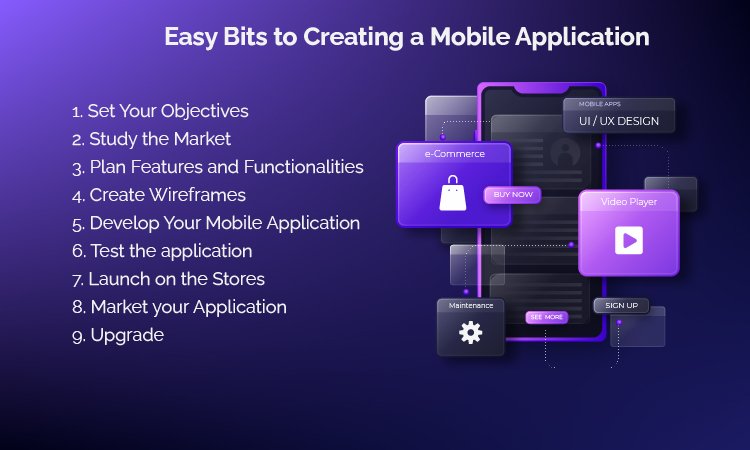6 Jan, 2022 | Mobile App Development
Pathway to Create a Successful Mobile Application

Easy Bits to Creating a Mobile Application
 Follow the below steps to excel in mobile app development.
Follow the below steps to excel in mobile app development.
1. Set Your Objectives
The app development process takes time. You can't simply think of an idea and create an app overnight. You need to consider a lot many things before transforming your idea into an application. You can spend a lot of money on app development, but if your objectives are unclear, you might not get the desired outcome. Therefore, the first step to creating an application is to define your objectives and figure out why you need a mobile app, as every application developed has a purpose to serve. The reasons to develop a mobile application can be many, some of which may include: - To create brand awareness - To reach more customers - To solve a particular problem With so many reasons for development, your app should necessarily satisfy the following two goals - your ideal user's needs and your business goals.2. Study the Market
When you think of developing an application, you just think of an idea on paper. However, an idea that works on paper might not be successful among people. Studying the market will help you distinguish between the two, saving your time, money, and efforts in the development process. The ultimate goal of every entrepreneur is to seek affordable app development solutions. Conducting proper market research before the development clarifies the prospects of your application in the target market. In addition, market research may help you in: - Identifying the loopholes in your idea - Validates the credibility - and identifying the top niche competitors. Studying the market helps create the base for market-ready end products that have a higher chance of success. Therefore, do not be afraid to change your app idea if it does not provide you with the desired results.3. Plan Features and Functionalities
This is one of the most creative steps in developing a mobile application. In this step, you can list out all the features and functionalities you want in your application in order to achieve the solutions and get the desired results. This is known as the MVP version of the app. The best way to follow this step is to research what features your competitors offer on the App Store and the Google Play Store. Try to integrate trending features like Machine learning, Artificial Intelligence, AR and VR, Face Detection, Payment Gateway Integration, etc. If these features solve your prospect's problem, definitely integrate them while creating a mobile app.4. Create Wireframes
Wireframes are barebone skeletons that serve as the foundation for an app design. They show how a product will work without focusing on the layout, screen arrangement, or user experience. Wireframes are created on paper, whiteboards, or computer displays and can be used for a variety of purposes like: - Lay Down app usability - Validates app functionality - Simplifies your project transition - Establishes transparent communication - Visually shows how every page will work As a simple visual draught, Wireframes can safeguard your project from several unwelcome shocks. You'll be able to recognise outliers, plan for deviations from the plan, and generate a financial edge once you understand what each page is supposed to perform.5. Develop Your Mobile Application
Whether you want to do it yourself or you want to hire a dedicated mobile app development agency, the wireframe will make the job easier for you. Whatever you choose, the ultimate goal is to create a human-friendly application with a simple user interface. Ensure integrating the top design trends and follow UI/UX best practices to come up with a digital product that can satisfy your users. Below are a few design trends that will help you create an application that would thrive in the market. - Cross-platform application - Intuitive design - provide customisation choices - minimise data input - use well-established gestures - keep the loading speed to the minimum level The standard for visual and graphic design continues to rise in accordance with current user behaviour. Animations and simulations, as well as pixel-perfect details and breathtaking graphic effects, are all available. Make the most of them to get the most out of your prototype.6. Test the application
After you've completed the app development process, test your mobile app to guarantee there are no issues and that the user experience is simple. While there are many different types of testing, we recommend doing at least two: an internal test and an external test. The goal of app testing is to find and fix bugs and user interface concerns. External testing and providing a rich user experience can be done by tools such as TestFairy, UserTesting, and Ubertesters. For every piece of software, there are two forms of testing. The core architecture and functions of an app are thoroughly examined during whitebox testing. The internal perspective and programming abilities of a system are used to construct test cases. While blackbox testing investigates an app's functionality without looking at its internal workings or structures, whitebox testing examines the app's internal workings and structures. The tester knows what the software is supposed to do, but not how it does it.7. Launch on the Stores
Apple App Store and Google Play Store remain the two most popular mobile app distribution platforms. So, at the absolute least, launching your mobile across both of these is the obvious best option. As a result, your client base will be exposed to a wider range of prospects, more social chances, and, as a result, greater monetisation. You can either design a cross-compatible process or separate codes for different environments. Make that decision before you begin the process of developing an app. Keep in mind that while cross-platform applications are cost-effective, native applications have their own set of advantages. Examine and observe. After that, make a decision.8. Market your Application
It's a frequent misconception that well-developed applications don't require marketing, but this isn't the case. Marketing is the voice that tells users about who you are, what you stand for, and how you distinguish from the competition. These days, most businesses have a particular marketing and advertising budget. You can begin promoting your app whether or not it has been released on the app store. For example, use a banner on your website, write a dedicated blog post about the app, send emails to your existing customers, promote it on social media platforms like Facebook by creating interactive videos, upload photographs or videos to YouTube, and tweet about it.9. Upgrade
Once the app is launched in the stores and people start using it, they tend to give their feedback which can be analysed and used wisely to upgrade your stores accordingly. This gives you the potential to drive more clients, conversions, and revenue. All you have to do is figure out how to collect the feedback effectively and how to incorporate those feedbacks for better app performance. For collecting feedback from the right individuals, you can use the mobile app analytics tools and reach out to the customers to gather as much information as you can. After collecting the feedback, sit with your team of mobile app developers and strategists to solve every user problem efficiently. Accordingly, upgrade your application in order to offer a better user experience.So What Are the Steps of Creating Android App??
You have the answer!! We hope you found the article helpful and that you could find an answer to your query about how to develop a mobile application from scratch. As your brand-new app is now gaining traction, it's time to assess your abilities in these android app development process steps and work to improve them. If you require assistance from a professional mobile app development agency, you can get in touch with us.Frequently Asked Questions
To prioritize features and functionalities in your mobile app, it's important to first understand the needs and preferences of your target audience. Conducting market research and gathering feedback from your target audience can help you identify the most important features and functionalities that they are looking for in an app. Once you have this information, you can prioritize these features based on their importance and relevance to your target audience. You can use techniques such as the MoSCoW method (Must have, Should have, Could have, and Won't have) or the Kano model to identify and prioritize features based on their impact and satisfaction level for your users. Ultimately, it's important to continually gather feedback and iterate on your app to ensure that you are meeting the evolving needs and preferences of your target audience.
One effective way to promote your mobile app in the UK market is through social media. Your app's social media accounts should be active and engaging, with regular posts about the app's features and benefits. You can also leverage social media advertising to target specific demographics based on age, location, interests, and more. Another strategy is to connect with bloggers, influencers, and reviewers in your niche. Offer them a free trial of your app in exchange for an honest review or a mention on their website or social media channels. Partnering with other businesses can also be an effective way to reach potential users. For example, if your app is a food delivery service, you could partner with a local restaurant to offer exclusive discounts to its customers. Lastly, ensure that your app is easily discoverable on app stores by optimizing keywords, app descriptions, and screenshots. Utilize app store optimization tools to increase visibility and downloads.
When deciding which mobile platforms to target, it is important to first consider the user demographics of each platform. In the UK, iOS tends to have a more affluent user base, while Android dominates the market share. Windows phones have a smaller market share but may still be worth developing for depending on your target audience. It is also important to consider the development resources and capabilities of your team or company. If you have a larger team with more experience in iOS development, it may be more efficient to focus on that platform first. Ultimately, it is important to conduct market research and analyze user behavior to determine the best platform to target for maximum reach and engagement.
based on research, one of the most challenging aspects of mobile app development is keeping up with the rapid pace of technology advancements. You need to constantly update your skills and knowledge to ensure that your app always performs well on the latest devices and operating systems. Another challenge is user engagement and retention, as the market is oversaturated with apps, and you need to find creative ways of standing out from the competition and keeping users engaged.
According to recent surveys conducted in the UK, consumers value mobile applications that offer a seamless user experience, with easy navigation and fast loading times. Features such as personalized recommendations, push notifications, and loyalty programs also score highly among consumers. Additionally, security and privacy are becoming increasingly important to UK consumers, with more and more people wanting control over their data and the ability to opt-out of targeted advertising. Finally, social media integration and the ability to connect with friends and network with like-minded individuals are also highly valued by UK consumers.

